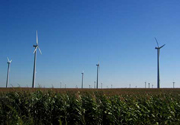By Oakley Brooks

There’s a lot of hand-wringing these days about the mediocre American record on clean energy. No federal climate legislation. No federal mandates for clean electricity. And when Americans look to incentive-laden Europe or to the huge clean-tech investments being made in China and Korea, we feel like an aged, belching Geo Metro being passed on both sides by sleek bullet trains. President Obama calls it our “Sputnik moment,” referring to the 1957 Soviet launch of the first satellite into space, which kicked the U.S. space program into high gear and led to quick creation of the National Aeronautics and Space Administration or NASA. He’s hoping the nation will be similarly spurred into a new age of innovation – this time on energy.
But a recent report on state-level progress in clean energy shows the age has already begun: In the absence of clear federal leadership, a lively and varied innovation landscape has taken shape across the country. Beyond the usual suspects like California, Oregon, Massachusetts and Washington state, Midwestern states – blue, red and purple – have used state funds and incentives and recent federal stimulus money to build on local strengths and become leaders in things like electricity generation and cutting-edge research.
California is far and away at the top of December’s Clean Energy Leadership Index from industry consultants Clean Edge. The index charts 80 different measures, from pro-climate policies to the number of smart electricity meters to hybrid cars per capita to research institutions and green MBA programs in each state. California has a slew of things to recommend it – the nation’s most stringent climate law that will regulate greenhouse gases starting in 2012, incentives that make it the third largest solar energy market in the world, clean-tech-hungry venture capitalists, and hot companies like Tesla Motors in Silicon Valley.
Massachusetts, at No. 3, has mandated massive reductions in greenhouse gasses by 2050, while Oregon (No. 2) and Washington state (No. 4) have switched to hybrid cars and cleaner electricity at a rapid pace.
But in places like Iowa, Michigan and Ohio, there is also much intrigue.
The Hawkeye State leads the nation in clean electricity, with 14 percent of its electrons flowing from emission-free sources (not including hydro-electric installations). In Iowa, this means wind. Developers and manufacturers have flocked to the state to take advantage of ample open and windy farmland, tax credits for each kilowatt-hour of clean energy produced and tax exemptions for new equipment. With eight major manufacturers, industry employment topping 2,300 and transmission lines crisscrossing the landscape, the state is now exporting wind-generated electricity to other Midwestern states trying to meet renewable energy targets.
Michigan, meanwhile, has the most clean energy patents awarded of any state in 2009, the result of an aggressive push by university and private auto-industry researchers to retool cars – and Detroit’s rusted reputation – for a cleaner era. The patents are for things like battery technology and electric vehicle parts, fuel cells and even some solar innovations.
Both Michigan and Ohio are undergoing a transition from Steel Belt to Solar Belt, with close to 8,000 jobs in solar manufacturing between them as of October 2010. Stimulus funds have helped companies like DuPont revive shuttered factories in the region.
“Detroit and Michigan have near perfect infrastructure, and they have managerial know how,” says Ron Pernick, Clean Edge’s managing director. “If any place can capture the transport electric market it’s going to be Michigan or California.”
Competition among states for industry is often seen as a race to the bottom, with economic development officials serving up sweetheart, tax-free deals to lure big employers. But industry watchers say that the competition to build clean energy prowess and develop states’ homegrown competitive advantages could end up serving the nation well.
“All of these innovations – from smart meters to economic incentives to better battery storage systems – are necessary for the future,” says John Harte, a professor in the Energy and Resources Group at the University of California, Berkeley. “Different states will prove innovative in one area or another, and, ultimately, states that didn’t develop innovations start to copy others. We have to start borrowing from each other.”
Pernick says one of the drivers behind Clean Edge’s report was to make information about what’s working available to bottom-feeding states in clean energy.
That information will come at a cost – full access to the regularly updated index starts at $15,000.
But, for the sake of keeping clean-tech investments at home, the faster innovations and companies grow up and spill across state lines, the better. And the more federal policy supports that, the better.
Clean tech got a huge boost from the federal stimulus package passed in 2009, which allowed companies to take up 30 percent of the cost of projects like wind installations as a direct federal grant. But a report from the Washington-based Investigative Reporting Workshop found that a staggering 85 percent of the $1.05 billion in clean energy stimulus grants went to foreign-owned wind companies.
Clean energy advocates have often said that long-term policy, like federal tax credits for each kilowatt-hour of wind and solar energy produced, will allow domestic industry to sink deeper roots across the country. As it stands now, the wind portion of this on-again, off-again tax credit is set to expire yet again at the end of next year.
Read it at the source.
